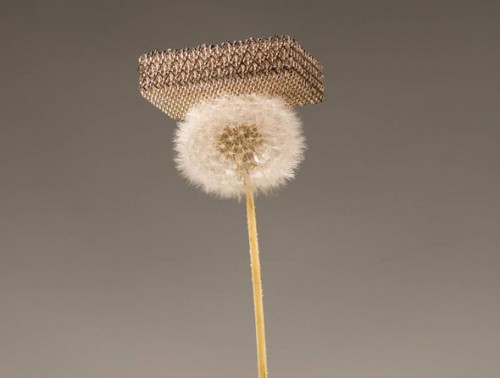The Lightest Material in the Entire World
Things are heavy right now, man. People are fighting wars, Wall Street is occupied, a large percentage of the workforce can’t find jobs, airport security procedures intensify in complexity by the minute, the rainforest is shrinking as I type … and that’s just the tip of the rapidly melting iceberg. So if you’re already feeling like Atlas with the weight of the world on your shoulders, you’ll be glad to find out that scientists recently invented a material so lightweight it makes styrofoam seem as heavy as a lead ingot.
In fact, “with a density of just 0.9 mg/cm3 the material is around 100 times lighter than Styrofoam and lighter than … ‘multiwalled carbon nanotube (MCNT) aerogel’ – also dubbed ‘frozen smoke’ – with a density of 4 mg/cm3” (Quick). Learn more about aerogels here.
Researchers at UC Irvine, HRL Laboratories and Caltech created an “ultralight metallic microlattice,” which, due to its nanoscale structural configuration vaguely reminiscent of the Eiffel tower, which consists 99.9% of air. The scientists claim that it is the lightest material on earth. To make the material, researchers fabricated “a lattice of interconnected hollow tubes with a wall thickness 1,000 times thinner than a human hair” (Netburn). It’s so unbelievably light that the researchers made a version out of nickel, placed it on top of a dandelion and … nothing happened; check it – the stalk didn’t even bend:
Photo: Ultralight metallic microlattice — which is 99.9% air — is so light that it can sit atop dandelion fluff without damaging it. Credit: Dan Little / HRL Laboratories
So how, aside from dandelion decoration, might we use an ultralight metallic microlattice? The new material demonstrates impressive strength and energy absorption, with the ability to recover from compression exceeding 50% strain. The small wall thickness-to-diameter ratio of the material allows the individual tubes to remain flexible and absorb energy (Quick). The microlattice demonstrates potential for awesomeness across a wide range of applications. It could be used for catalyst supports, acoustic dampening, as impact protection, vibration dampening, in the aerospace industry, possibly in airplanes to save weight and corresponding jet fuel, bike helmets, or maybe even battery electrodes.
I’d like to know if the manufacturing process is scalable, if it’s toxic in any way, what the cost is to make the material, and if its performance decays over time. But it’s exciting to think about the possibilities – and to imagine little ultralight metallic microlattice samples floating delicately to earth like so many swan feathers floating on the breeze.
The lightest material on earth has been filed … in earth (and metal).
Cited:
Netburn, Deborah. “Scientists Invent Lightest Material on Earth. What Now?” Los Angeles Times online. 11/17/11. Accessed 11/21/11. URL.
Quick, Darren. “Newly Developed Metallic ‘Microlattice’ Material is World’s Lightest.” Gizmag.com. 11/17/11. Accessed 11/21/11. URL.
Special thanks to @BBQSnob for the tip.

















Leave a Wordpress Comment: